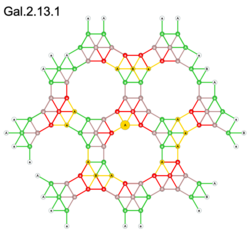OEIS/coors

Generating functions for coordination sequences of uniform tilings
For the 1248 k-uniform tilings determined by Brian Galebach, generating functions (g.f.s) for all corresponding 6536 coordination sequences (coseq.s) were "guessed" by Maple's gfun:guessgf from 128 initial terms. There is a tab-separated file with the result.
As an example we examine the two lines (coseq.s) for 'Gal.2.13 in this file:
2-Uniform Tiling 13 of 20 Standard notation: [3^6; 3^2.4.12] A301692 Gal.2.13.1 O.g.f.: (-x^13-2*x^12+3*x^10+5*x^9+8*x^8+11*x^7+13*x^6+14*x^5+12*x^4+9*x^3+7*x^2+4*x+1) / (x^10-2*x^5+1) Coefficients: 1,4,7,9,12,14,13,11,8,5,3,0,-2,-1 / 1,0,0,0,0,-2,0,0,0,0,1 a14>s11 Denom. factorized: (x-1)^2*(x^4+x^3+x^2+x+1)^2 A301690 Gal.2.13.2 O.g.f.: (x^10+6*x^9+6*x^8+9*x^7+12*x^6+16*x^5+12*x^4+9*x^3+6*x^2+6*x+1) / (x^10-2*x^5+1) Coefficients: 1,6,6,9,12,16,12,9,6,6,1 / 1,0,0,0,0,-2,0,0,0,0,1 s11=s11 Denom. factorized: (x-1)^2*(x^4+x^3+x^2+x+1)^2
The resulting rational g.f.s (with a numerator and a denominator polynomial) have several obvious properties:
- The coefficient lists are often symmetrical (the first half is mirrored, maybe around a center term). This is indicated by "s", or "a" for asymmetrical.
- The denominator coefficient lists are always symmetrical.
- If both the numerator and the denominator coefficient lists are symmetrical, the degrees are both odd (the leading numbers give the occurrences):
16 s3 =s3
42 s5 =s5
147 s7 =s7
241 s9 =s9
539 s11=s11
589 s13=s13
199 s15=s15
114 s17=s17
160 s19=s19
128 s21=s21
110 s23=s23
96 s25=s25
82 s27=s27
85 s29=s29
24 s31=s31
16 s33=s33
33 s35=s35
4 s37=s37
Factors of the denominator polynomials
When the denominator polynomials are factorized, there are only 34 different factors (the leading numbers give the occurrences of the factor):
6536 x-1
2208 x+1
2286 x^2+1 -> y+1
1635 x^2-x+1
3145 x^2+x+1
1320 x^4+1 -> y+1
1061 x^4-x^2+1 -> y^2-y+1
1246 x^4-x^3+x^2-x+1
2285 x^4+x^3+x^2+x+1
120 x^6-x^3+1 -> y^2-y+1
1448 x^6+x^3+1 -> y^2+y+1
271 x^6-x^5+x^4-x^3+x^2-x+1
1474 x^6+x^5+x^4+x^3+x^2+x+1
159 x^8+1 -> y+1
23 x^8-x^4+1 -> y^2-y+1
54 x^8-x^6+x^4-x^2+1 -> y^4-y^3+y^2-y+1
328 x^8-x^7 +x^5-x^4+x^3 -x+1
6 x^8+x^7 -x^5-x^4-x^3 +x+1
6 x^10-x^9+x^8-x^7+x^6-x^5+x^4-x^3+x^2-x+1
1492 x^10+x^9+x^8+x^7+x^6+x^5+x^4+x^3+x^2+x+1
11 x^12-x^6+1 -> y^2-y+1
34 x^12-x^10+x^8-x^6+x^4-x^2+1 -> y^6-y^5+y^4-y^3+y^2-y+1
6 x^12+x^11 -x^9-x^8 +x^6 -x^4-x^3 +x+1
5 x^12-x^11+x^10-x^9+x^8-x^7+x^6-x^5+x^4-x^3+x^2-x+1
32 x^12-x^11 +x^9-x^8 +x^6 -x^4+x^3 -x+1
452 x^12+x^11+x^10+x^9+x^8+x^7+x^6+x^5+x^4+x^3+x^2+x+1
6 x^16+1 -> y+1
6 x^16-x^12+x^8-x^4+1 -> y^4-y^3+y^2-y+1
89 x^16+x^15+x^14+x^13+x^12+x^11+x^10+x^9+x^8+x^7+x^6+x^5+x^4+x^3+x^2+x+1
12 x^18+x^9+1 -> y^2+y+1
59 x^18+x^17+x^16+x^15+x^14+x^13+x^12+x^11+x^10+x^9+x^8+x^7+x^6+x^5+x^4+x^3+x^2+x+1
18 x^20+x^15+x^10+x^5+1 -> y^4-y^3+y^2-y+1
6 x^22+x^21+x^20+x^19+x^18+x^17+x^16+x^15+x^14+x^13+x^12+x^11+x^10+x^9+x^8+x^7+x^6+x^5+x^4+x^3+x^2+x+1
6 x^24-x^23+x^19-x^18+x^17-x^16+x^14-x^13+x^12-x^11+x^10-x^8+x^7-x^6+x^5-x+1
We observe the following properties of for the denominators:
- All denominators have a factor (x-1)^2.
- All coefficents of x in the factors are +1 or -1.
- Except for the factors x-1 and x+1, all factors are of even degree.
- The number of different patterns could be further reduced (to 20) with substitutions x^(k*m) -> y^k .
- After such substitutions, the factors have the form sum(k=0..n: (+-1)^k * x^k), except for one pattern of degree 8 and two patterns of degree 12.